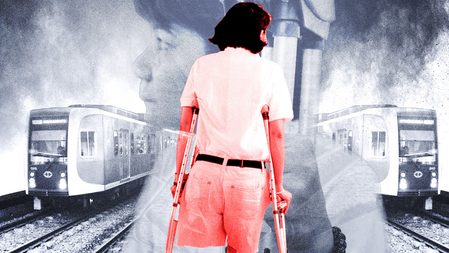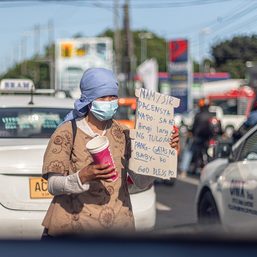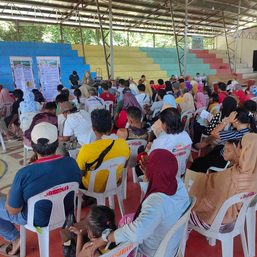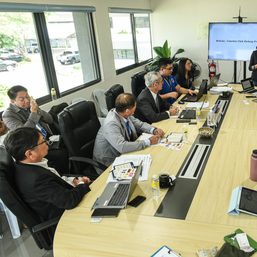SUMMARY
This is AI generated summarization, which may have errors. For context, always refer to the full article.

MANILA, Philippines – An accessible transport system leads to inclusivity.
The Department of Transportation (DOTr) sought to prove their commitment to this goal during a meeting on Thursday, June 5, when they presented various ways train lines under their supervision have addressed concerns of persons with disabilities (PWDs).
The operators of Metro Manila’s three train lines – Light Rail Manila Consortium (LRMC) for LRT-1, Light Rail Transit Authority (LRTA) for LRT-2, and the Metro Rail Transit Corporation (MRTC) for MRT-3 – listed down how they addressed the findings of a 2023 Rappler in-depth report, “How the Metro Manila train system fails persons with disabilities.”
In the meeting were various transportation department officials, led by railways assistant secretary Jorjette Aquino; persons with disability groups like Kasali Tayo; inclusive transport group Move As One Coalition, other accessibility advocates; and Rappler community head Pia Ranada, author of the Rappler report.
The Rappler report showed how PWDs find it challenging to commute alone due to blocked ramps, locked public toilets, unusable ticket vending machines, and the lack of elevators in many stations, among others. As a result of the story, the issue of PWD access in train stations was raised during the DOTr’s Senate and House 2023 budget hearings and led to a dialogue in October between persons with disability groups, the DOTr, and contractors building new train lines.

“The goal of DOTr is to provide a comfortable, accessible, safe transport system…We make sure we are always compliant, and all members of the community are addressed,” Assistant Secretary for Railways Aquino said during the Thursday meeting.
Here is a summary of all identified facilities and services with gaps, and how each operating line is addressing these:
Tactile flooring
Most LRT-2 stations and all MRT-3 stations were found to have inconsistent tactile flooring. This was a challenge raised by some visually impaired individuals who rely on tile patterns to navigate their way around. These were addressed by:
- LRT-1 – Improved tactile tiles made of sustainable materials, such as recycled plastic, will be completely installed in all stations.
- LRT-2 – Did not indicate.
- MRT-3 – So far, tactile tiles are only limited to edge tiles found in platforms. To better study the implementation of tiles for visually impaired individuals, they are planning to establish a mode of agreement with the School of the Blind.
Ramps and platforms
Ramps were either missing, usually blocked by obstruction, or used as motorcycle parking barring access to users. Meanwhile, the level between platforms and trains are reported to be uneven. Some steps taken are:
- LRT-1 – Ramps are modified to have a less steep slope that is more friendly with PWDs in wheelchairs. These will be installed in all entrances of the upcoming Cavite extension project.
- LRT-2 – From the report, it was raised that some ramps, especially at the Pureza and V. Mapa stations cannot be easily seen in entrances; while ramps at the Katipunan station south entrance and Antipolo Station are too steep. The management is currently processing how to address these but extra personnel are temporarily situated in case of assistance. While it was mentioned that ramps are cleared in all stations, Kasali Tayo reported to Rappler that ramps at Recto Station are still blocked, just a few days after the meeting. Rappler informed DOTr and LRTA staff who, as of June 11, said the ramps were now cleared of obstruction.
- MRT-3 – Ramps are now clear and accessible to all stations, except for Taft Avenue station – where the installation from the station’s adjacent establishment is still pending. According to management, they are currently working on its layout and will require staff assistance in the meantime. Meanwhile, platform doors and gap fillers on the space between the train and platform are considered for future projects.
Elevators and escalators
Entrances in some stations either lack or have elevators under maintenance. Due to limited space, LRT-1 was even the worst performer in terms of accessibility via elevators, according to Rappler’s report. Here’s how they resolved this issue:
- LRT-1 – Functionality of all elevators and escalators are now being checked regularly. An emergency response system was also installed inside elevators to ensure that trapped people can go out within five minutes.
- LRT-2 – Did not indicate.
- MRT-3 – All elevators and escalators are operational in all stations. However, it was mentioned that MRT-3 typically shuts down elevators during heavy rains. In case of maintenance, downtime should be limited to within 24 hours for minor issues, and 48 hours for major issues. Meanwhile, elevator and escalator lifts are considered for future projects, especially to stations, such as the Ortigas and Cubao stations, that cannot accommodate elevator shafts due to limited space.
Comfort rooms
From Rappler’s audit, 40% of all stations lacked features of a PWD-friendly comfort room. Some did not have any handrails and lacked sufficient space for wheelchair users. Others are completely inaccessible due to the lack of indicators that they are for PWDs, and were used as storage rooms or locked unless requested to staff. These were addressed by:
- LRT-1 – All PWD comfort rooms are now open and easily accessible.
- LRT-2 – PWD and gender-neutral restrooms have been established in all stations. These feature grab bars near toilets and a diaper-changing facility.
- MRT-3 – All comfort rooms are accessible and portable ramps are not required for PWDs to enter. They also use PWD signages in entrances, and features installed grab bars and appropriate labels in toilet areas.
Ticket vending machines
Some common features missing in ticket-vending machines across all stations are the lack of tactile buttons, braille, and text-to-speech functions needed by those with visual impairment. The resolution:
- LRT-1 – To avoid long lines, tickets can be purchased in advance via the ikotMNL app – LRT-1’s official app, using a QR code ticketing system. However, this still does not address the accessibility for visually impaired individuals.
- LRT-2 – Additional personnel were advised to assist PWD passengers when necessary.
- MRT-3 – Additional personnel were advised for assistance. PWDs are considered a priority for ticket lines. In case machines are down, staff are asked to line for them in ticket booths. Service gates are also provided for all PWDs so they won’t have to join large crowds.
Announcements, protection from hazards
For key announcements and hazards, persons who have visual disability rely on audio announcements made by train operators and guards situated at the station. However, some train stations were inconsistent with these announcements. Some steps taken by operating lines:
- LRT-1 – Real time advisories and important announcements can be accessed via the ikotMNL app, including train schedules, maintenance issues, and crowd monitoring, among others. This, however, does not address needs of those with visual impairment. No resolution for audio announcements were mentioned. LRT-1 users are also told to use the RIA Safety app, which stands for Report, Recognition, Information, and Action, to receive photos and reports of incidents in LRT-1 stations.
- LRT-2 – Additional “wet floor” caution signages are being procured.
- MRT-3 – Route maps and other passenger information signages inside trains were made more visible, cleared of obstruction. Audio information and recorded announcements will also be done regularly by station supervisors.
All stations mentioned that all public announcements, advisories will be posted on social media in advance.
Staff training
While all stations rely mostly on human assistance to make up for faulty facilities, it was reported that most staff lack comprehensive training on how to handle passengers with disabilities.
As a result, the Mobility, Inclusivity and Accessibility Committee, in collaboration with trainers from the National Council on Disability Affairs, is working on implementing a Disability-Related Sensitivity Course for all train employees, especially frontliners, station supervisors, and ticket sellers.
The training was already applied to MRT-3 staff in May 2023, and will be done to LRT-2 staff in July. While the frequency of these trainings has yet to be finalized, MRT-3 said they’re eyeing to do this quarterly.
For additional assistance, commuter’s welfare desks are also situated in all MRT-3 stations. However, due to limited resources, they can only provide personnel to major stations such as North Avenue, Araneta-Cubao, and Shaw Boulevard.
Personal mobility aids, bikes, dedicated spaces
Most concerns identified were usually about services and facilities found inside the train station. However, LRTA also implemented other measures to better cater to the needs of PWDs inside trains.
Most “4th generation” (Gen 4) trains of LRT-1 are now in use. These larger, new train carriages feature a dedicated section for individuals in wheelchairs, as well as women and senior citizens. Intercom devices are also installed in some areas inside the train so passengers can easily notify train operators in case of emergency.
Meanwhile, LRT-2 is also providing designated areas specifically for commuters with mobility devices such as wheelchair users and individuals carrying folding bikes and e-scooters. A policy that explicitly allows personal mobility aids like electric wheelchairs has been finalized in LRT-2 to ensure consistent implementation by guards, said LRTA administrator Cabrera.
LRT-1 has also installed bike racks in all stations and partnered with the Pasay government to establish bike lanes from Libertad station to Makati. Because of the Gen 4 train carriages, LRT-1 operator LRMC is now considering a policy of allowing bicycles. Meanwhile, for LRT-2, which allows folding bicycles, there is a proposal to allow full-sized bicycles outside of rush or peak hours.
Feedback from persons with disability
PWD and mobility advocates commended these “progressive realizations” presented by each operating line. However, according to them, there are still some points that need to be strengthened and revisited in order to commit to total inclusivity.
In terms of accessibility in facilities, Kasali Tayo’s Bless Adriano suggested providing sufficient captions and alternative text to social media advisories to cater to visually impaired individuals. Architect Armand Eustaquio also added that braille symbols in elevators and signages should be explored. He also pointed out that most restrooms do not provide enough space beside toilets for side transfers of persons in wheelchairs.
Meanwhile, most recommendations focused on the Disability-Related Sensitivity courses offered to train personnel. According to Move as One Coalition’s Maureen Mata, information dissemination about addressing needs of PWD commuters should be a whole-of-society approach. This includes sharing infomercials on how PWDs take their daily commute to instill changes in public behavior and attitudes in approaching the vulnerable sector.
Move as One Coalition’s Krissy Bisda also stressed that these trainings should be institutionalized and automatically included in the onboarding process of new hires. The inclusivity trainings would also benefit other vulnerable groups like LGBTQIA, women, children, and the elderly.
Frankie Nobleza of Kasali Tayo proposed that these trainings should also raise awareness about non-apparent disabilities such as autism and attention-deficit/hyperactivity disorder (ADHD). To improve the course, Mata and Eustaquio cite that these trainings should be in the annual budget allocations of the DOTr and must be capacitated by the Philippine Railways Institute.
All recommendations were noted by the DOTr and will be considered in future railway projects. – Rappler.com
To read live updates from the June 5 meeting, check out the Liveable Cities chat room in the Rappler Communities app.
More accessible and inclusive trains helps #MakeManilaLiveable. Rappler is helping push for better quality of life in Philippine cities and amplify liveability as a key governance issue. Learn more about the #MakeManilaLiveable campaign here.
Add a comment
How does this make you feel?




![[Under 3 Minutes] When will we see modern jeepneys on the road?](https://www.rappler.com/tachyon/2024/04/francisco-motors-modern-jeepney-prototype-1.jpg?resize=257%2C257&crop=590px%2C0px%2C1012px%2C1012px)











![[Ask the Tax Whiz] Can senior citizens and PWDs avail VAT-exemption on their online transactions?](https://www.rappler.com/tachyon/2022/12/online-shopping-december-21-2022.jpg?resize=257%2C257&crop=154px%2C0px%2C900px%2C900px)
There are no comments yet. Add your comment to start the conversation.